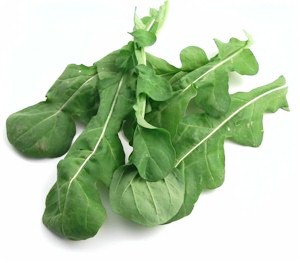The most enticing salads balance sweet, peppery and bitter tastes with frilly, flat, crisp and soft textures. Mixing colors and shapes also contributes to a salads' visual appeal.
Leaf lettuces and greens provide more flavor and nutrition than iceberg lettuce. In fact, a mixed greens salad provides seven and a half times more vitamin C, 10 times more iron, 35 times more vitamin A, calcium and fiber per serving than iceberg.
It’s easy to get in a salad rut, turning to the same kind of lettuce every time. Why not go beyond iceberg, romaine, or leaf lettuce and try some more interesting options? Spring is the perfect time to experiment with salad greens, and this post will help you get acquainted with all that leafy stuff at the grocery store.
When you purchase or harvest lettuce, you should wash or rinse it, then store it wrapped in a cloth or paper towel, then in a plastic bag, in the crisper drawer. Store lettuce away from apples, pears and bananas. These fruits release ethylene, a ripening agent which will speed the decay of the lettuce. Because of its high water content, lettuce cannot be frozen or canned for long-term storage. It should always be eaten fresh, within about 10 days of purchase or harvest.
Nutritional content varies among lettuces and greens, though most are filled with Vitamin A and potassium. With the exception of iceberg, most varieties are also a good source of Vitamin C, iron and calcium. Lettuce is also a good source of dietary fiber.
The following list and photos provide you with an amazing variety of leafy greens for healthy salads and recipes.

 Belgian Endive is a chicory known for its succulent and velvety creamy-white leaves with a mildly bitter flavor.
Belgian Endive is a chicory known for its succulent and velvety creamy-white leaves with a mildly bitter flavor.Cilantro is a member of the parsley family and lends a strong and unique flavor to salads. It is often used in Mexican, Caribbean, and Asian cooking.

Collard Greens is a cruciferous vegetable and a member of the cabbage family. These greens have a fairly mild flavor similar to green kale. The leaves are sturdy and best when cooked.

Dill is an herb with beautiful feathery leaves and a distinct flavor that's strong when fresh but mellow when it's cooked or dried.

Frise` is a chicory also known as curly endive. It adds a fresh flavor and attractive texture to salads with it's frill leaves and white heart.
Green Curly Kale has a cabbage-like flavor and frilly thick leaves that hold their shape better than other greens when cooked.
Green Leaf Lettuce, as well as red leaf are popular spring greens. Green leaf lettuce is a rich source of vitamin A, vitamin K and C.
Mache Rosette is a mild, tender and buttery flavored green with delicate teardrop shaped leavesthat are delicious in salads.
Radicchio, also known as Italian chicory, has a mildly bitter flavor. Its beautiful red leaves with white veins are a delicious and striking addition to salads.
Romaine lettuce (also known as cos) have long green leaves, with a crunchy center vein and the taste is bitter and succulent. This lettuce is used in a Caesar salad, or great for a taco salad
Spinach (Baby Spinach) has a mild and delicate flavor. Baby spinach leaves have a bolder taste and are packed with a variety of nutrients.
Tango, with its bright green color makes a gorgeous salad, especially when paired with a red leaf lettuce, and the crisp texture holds up well to a variety of salad dressings.
Certain vegetables are worth buying organic, and greens are one of them!
What leaf lettuces and greens do you use most often? Please leave your comments and suggestions in the comments below!
Laurel ♥












No comments:
Post a Comment
Please send your comments to Healthy Intuitions: